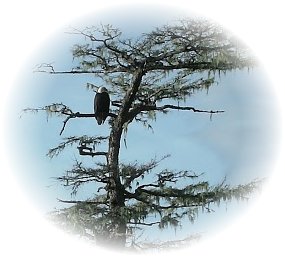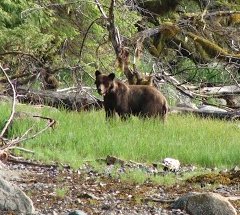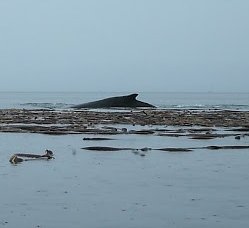- Home
- Go Paddle
- Trip Finder
- The Inside Passage in Alaska
The Inside Passage in Alaska
Trip Overview
 Inside Passage Wildlife Encounters
Inside Passage Wildlife Encounters
It was day 38 of my 79 day, 1,300 mile (2,080km), Inside Passage solo kayaking adventure. I had left Bellingham, WA five weeks earlier and would not land in Prince Rupert, BC for another 10 days. I was in a groove, making good time, and everything was going well, maybe too well.
The spot that I chose to camp this evening was at the western end of Higgins Passage on the shoreline of Price Island. (Coordinates: 52�28.519N x 128�45.328W) I could not have found a more remote location in all of British Columbia to spend the night. Sea swells rolling in from some distant storm in the Pacific were crashing onto a group of small islets that created a calm lagoon in front of my campsite. I had not seen another person or even a boat for the last three days. If it were not for the vapor trails of commercial airliners passing silently 30,000 feet (9,144 meters) overhead, I might have thought that I was the last person on earth.
After weeks of paddling and camping I had established a routine for setting up camp, fixing dinner, and doing daily chores. After landing on this day I unloaded my boat, changed into dry clothes, and set up my tent in the woods. I found a large tree about 30 paces from my campsite and threw a long rope over one of its branches that would be used later to hang my food cache. It was time to start fixing dinner.
I set up my kitchen on a gravel beach that would be underwater at high tide knowing that any food smells that I might leave behind from cooking would be erased. My alcohol stove was burning silently and a pot of water was heating up for coffee and a pot of stew. While I waited for the water to boil, I sat quietly on the beach filling in my journal with the events of the day. After mentioning the Humpback Whales and pod of Orcas that I had spotted earlier in the day, the last words that I wrote were, "It looks like bear territory." That was when my quiet evening ended.
 I saw something swimming through the calm water heading for the beach where I was sitting. The big round ears told me that it was not a sea lion or river otter which by now I was accustomed to seeing on a daily basis. Instantly I realized it was a bear - a Brown Bear!
I saw something swimming through the calm water heading for the beach where I was sitting. The big round ears told me that it was not a sea lion or river otter which by now I was accustomed to seeing on a daily basis. Instantly I realized it was a bear - a Brown Bear!
I grabbed my pepper spray and camera and jumped to my feet. I started yelling at the bear in a stern voice, "Get out of here bear", as I took a few steps toward it. The bear apparently had no idea that I was there because I think I scared him as he immediately took off running toward the tree line. Right before he reached the trees he stopped for a moment to take a look at me. That is when I snapped his picture. With the picture taken, I immediately went into "crazy-man mode" and attempted to scare the bear off with continuous volleys of, "Get out of here bear" as I moved slowly in his direction.
(Note: If this would have been a Brown Bear mother with cubs, I would not have acted aggressively like this, opting instead to remain calm, quiet, and non-threatening.)
I tried to put on a brave face but my heart was beating so hard that it felt like I had just run a 500 yard (457 meter) sprint. I am pretty sure I could even hear the blood pumping through the blood vessels in my ears. I amazed myself though, and stayed calm and in control of my emotions the whole time.
After the bear disappeared into the woods I went on high alert. I kept looking to see if he was still around when I spotted him standing on his hind legs looking down at me from a small hill up in the forest. I again started walking toward him yelling and waving my arms the whole time. He dropped down onto all fours and quickly ran off into the thick woods. My idea was to make him think that I was not scared of him and hopefully he would leave me alone. My amateur animal psychology must have worked because I did not see him again. I did not know this at the time and went into full bear avoidance mode for the rest of the evening.
Sleeping up in the trees where I had set up my tent was now out of the question. I took down my tent and retrieved the rope I had set up to hang my food cache. There was a small cliff at the top of the beach where I could set up for the night and be protected on at least one side. I did not set up my tent opting instead for just a tarp in case it started raining. To keep from being too vulnerable, I stayed dressed and just wrapped my sleeping bag around me. I spent the few hours of darkness like this only half asleep. The bear did not return.
That was the only really dramatic animal encounter that I faced on my 2012 Inside Passage trip. Most of the creatures that I ran into were much less threatening and only afforded unique photo opportunities.
 On day 69 when I was approaching Cape Fanshaw at the intersection of Frederick Sound and Stephens Passage I had some Humpback Whales put on a show for me that I will never forget. I was paddling between the rocky shoreline and a line of Bull Kelp that formed a continuous band about 100 yards (91 meters) off-shore. Humpback Whales were apparently feeding along the outer edge of the kelp bed and repeatedly surfaced with mounds of kelp piled onto their backs. I had never seen this behavior before and was unaware that Humpbacks would move through thick beds of kelp in this manner.
On day 69 when I was approaching Cape Fanshaw at the intersection of Frederick Sound and Stephens Passage I had some Humpback Whales put on a show for me that I will never forget. I was paddling between the rocky shoreline and a line of Bull Kelp that formed a continuous band about 100 yards (91 meters) off-shore. Humpback Whales were apparently feeding along the outer edge of the kelp bed and repeatedly surfaced with mounds of kelp piled onto their backs. I had never seen this behavior before and was unaware that Humpbacks would move through thick beds of kelp in this manner.
Another thing that the Humpbacks were doing was to make a really unusual sound while they were underwater in the kelp. This sound was clearly and loudly audible on the surface. The best way that I can describe the sound is that of a high performance dragster spinning its wheels at the start of a race. The sound would last for about five seconds then be repeated again thirty seconds later.
 Besides bears and whales, I spotted numerous colonies of Stellar Sea Lions and Harbor Seals perched on smooth rocky islets. Bald Eagles, Harlequin Ducks, Oystercatchers, Loons, and Gulls filled the sea surface and skies. Sea stars, urchins, and anemones covered the shoreline rocks exposed by low tide. River Otters, minks, and weasels made almost daily appearances and I even had three deer walk right into my camp one evening.
Besides bears and whales, I spotted numerous colonies of Stellar Sea Lions and Harbor Seals perched on smooth rocky islets. Bald Eagles, Harlequin Ducks, Oystercatchers, Loons, and Gulls filled the sea surface and skies. Sea stars, urchins, and anemones covered the shoreline rocks exposed by low tide. River Otters, minks, and weasels made almost daily appearances and I even had three deer walk right into my camp one evening.
The Inside Passage is a great place for any wildlife lover to go exploring and view an incredible variety of wild animals in their natural environment. Whether you cover the entire route, or just pick a section of it to paddle, you are guaranteed to spot lots of interesting wildlife along the way.
For more information and photos of my Inside Passage kayaking adventure, visit my website at:
https://sites.google.com/site/seakayakingtheinsidepassage/
Outfitting:
East Rider Eskimo Expedition 17 Ft. Sea KayakFees:
During the paddling portion of the trip you have to check in with customs when crossing into Canada and then again when crossing back into the US. There are no customs checks on the return trip on the ferry.Directions:
Drive to Bellingham, WA.Paddle to Skagway, AK.
Take the Alaska Ferry back to Bellingham, WA.
Drive home.
Resources:
I printed out all of my charts using Chart Navigator Pro software.
I wrote "Alone in the Passage: An Explorers Guide to Sea Kayaking the Inside Passage" after paddling the Inside Passage twice.
Trip Details
- Skill Level: Advanced
- Water Type: Open Water/Ocean